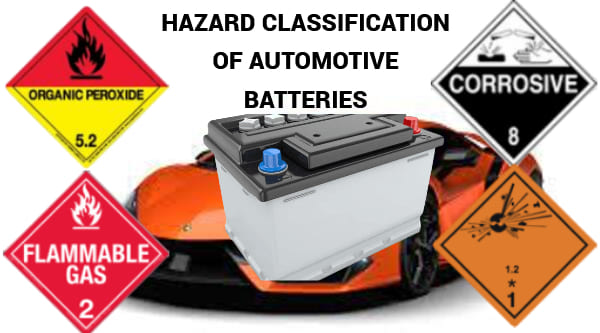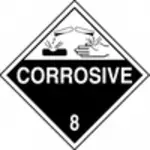Automotive Batteries are an example of which Hazard Class?
Question:
Automotive batteries are an example of which hazard class?
Answer to the question “Automotive batteries are an example of which hazard class” is class 8 – corrosive substance
The automotive batteries are an example of hazard class 8 and are an essential component of vehicles. Batteries supply power to start the engine and run other electrical functions. Performance and functionality of modern automobiles would be seriously affected without a reliable battery. Even if the engine is not running, batteries provide as a reliable source of energy to keep the electrical systems operational.
But always remember that batteries are classified as hazardous materials due to the potential risk they have. In this blog post, we will discuss automotive batteries are an example of which hazard class? And what precautions are necessary to handle automotive batteries safely.

Hazard Classification of Automotive batteries
It is very important for every driver to be aware of “automotive batteries are an example of which hazard class” for various reasons like safety, emergency, environmental protection, storage and transportation.
Hazard Class 8: Corrosive Substances
When it comes to transportation regulations, automotive batteries are an example of Hazard Class 8. The hazard Class 8 encompasses corrosive substances that have the potential to cause damage to biological tissues, metals, and other materials upon contact.

The corrosive electrolytes, often sulfuric acid, that are present in batteries are the main reason for this classification. If the corrosive materials are not handled appropriately, they could harm other materials as well as living things.
It’s important to note that hazard classes and their classifications may vary slightly depending on the regulatory framework and country. The above information provided here specifically belongs to the United States.
Recognizing the Potential Hazards of Automotive Batteries
The lead acid automotive batteries are an example of hazard class 8 as corrosive hazardous materials. The corrosive nature of automotive batteries makes them potentially dangerous if not handled properly or damaged. The sulfuric acid can cause severe burns the skin and eyes if someone touch it.
Additionally, when combined with other compounds or subjected to extremely high or low temperatures, it may emit dangerous vapors. Batteries contain lead and other heavy elements that pose environmental dangers if they leak or are disposed of inappropriately.
Safeguards to Take When Handling Automotive Batteries
While automotive batteries are not generally considered explosives. However, these can be dangerous in high temperature or if physically damaged. To maintain personal safety and avoid any potential risks brought on by their special features, automobile batteries must be handled properly.
Personal Protective Equipment:
It is very important to wear gloves and other protective equipment when handling automotive batteries. These safety measures will offer defense against corrosive electrolyte when in direct contact.
Proper Storage:
Store automotive batteries in a cool and dry area. Due to extreme temperatures, the battery may discharge or leak harmful gases.
Transportation Guidelines:
Follow transportation guidelines and regulations when shipping or transporting automotive batteries. This includes packaging the batteries securely to prevent damage or leakage during transit.
Safe Installation and Removal:
When installing or removing an automotive battery, take precautions to avoid accidental short circuits. Make sure that the electrical system of vehicle is turned off and disconnect the negative terminal before the positive terminal. Always remember to connect the positive terminal before connecting the negative terminal when installing a new battery.
Proper Disposal and Recycling:
The automotive batteries must be disposed of according to the correct safety procedures. Automotive batteries should never be disposed of in regular waste container. Instead, they ought to be delivered to authorized recycling facilities or battery merchants with recycling services. This will guarantees that the automotive batteries will be handled in environment friendly way.
Final Opinion
Our cars are powered in large part by automotive batteries. The fact that they are considered hazardous materials must be acknowledged. Due to their corrosive nature, these batteries fall under Hazard Class 8. Therefore they need to be handled and disposed of carefully to reduce any threats to human health and the environment.
Remember when it comes to vehicle batteries then environmental responsibility and safety should come first.
Frequently Asked Questions (FAQs) concerning Automotive Batteries
What hazard class are automotive batteries?
Automotive batteries typically fall under the hazard class of Class 8 – Corrosive Substances. Based on the characteristics of the electrolytes found inside the batteries, which are frequently corrosive and can harm biological tissues upon contact.
Are There Any Safe DIY Methods to Dispose of Old Automotive Battery?
It is highly recommended to avoid DIY methods for disposing of old automotive battery due to their hazardous nature. Instead, bring your old batteries to authorized collection points, recycling centers, or automotive shops that offer battery recycling services. These facilities are equipped to handle automotive batteries safely and ensure that the hazardous components are properly managed and recycled.
How Can I Identify the Hazard Class of a Specific Automotive Battery?
The hazard class of a specific automotive battery can usually be identified by referring to the battery’s safety data sheet (SDS) or the product label. Safety data sheet or product label give information about the hazardous characteristics, including the material’s hazard class and associated risks.
What are the Legal Regulations Regarding the Transportation of Automobile Batteries?
The number of legal regulation have been passed in USA to increase security and lessen risks when transporting automobile batteries. Regulations may include requirements for proper packaging, labeling, handling, and transport practices, depending on the specific hazard class of the batteries.
You are carrying a load of hazard class 8. What should be included with the shipping papers?
When transporting a hazardous material of hazard class 8, which pertains to corrosive substances, the following documents should be included with the shipping papers:
- Material Safety Data Sheet
- Shipping Labels and Placards
- Shipping Manifest or Bill of Lading
- Information of Emergency Response
- Marking and Labeling Information

